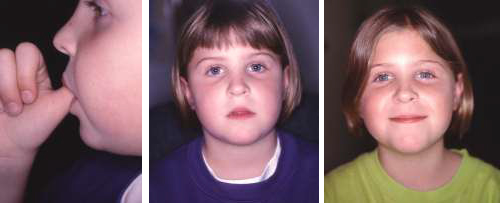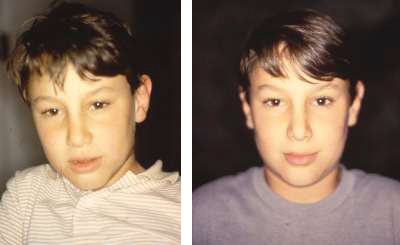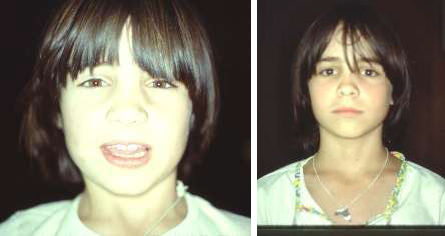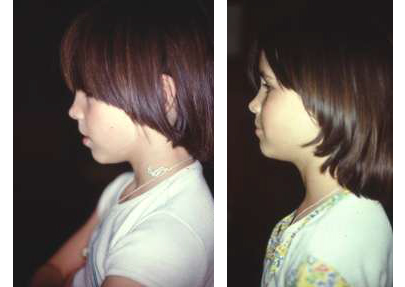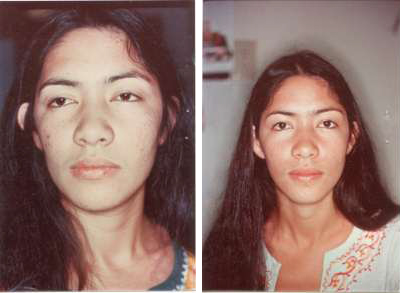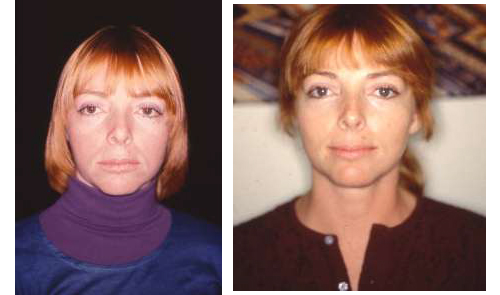Question & Answer - Oral Sensory-Motor, Myofunctional, Vocal Tract, & Airway Information
What is Orofacial Myofunctional Therapy? - Part 2: Before and After CasesJuly 2015 |
|||
|
Answer from Barbara J. Greene, Orofacial Myofunctional Therapist and Instructor in Santa Barbara, CA Here are some before and after cases which demonstrate the information presented in Part 1. Girl, Age 8
A motivational program was utilized to help this girl stop her thumb sucking habit. Her parents reported that the habit was corrected in just one day! The non-sucking habit was reinforced with a month of follow-up. Then, therapy exercises were implemented to correct her mouth breathing, low rest tongue posture, poor head-neck-body posture, deviated anterior swallow (causing an over jet and open bite), poor tongue placement during speech sound production, congestion, and poor habit patterns at rest and associated with eating, drinking, and sleeping. In less than 6 months of treatment, her parents reported seeing a change in her facial form with her lips being closed at rest and nose breathing instead of mouth breathing. Her overall posture improved, and all habit patterns were reported as corrected. Boy, Age 9
At age 9, this boy had been dropped from the school speech program due to lack of progress after 4 years of treatment. He presented with low self-esteem, and he sucked 2 fingers throughout the day and night. He also had his lips apart at rest with mouth breathing; allergies; 24-hour congestion; daily headaches and stomach aches; gas, burping, and hiccups; poor head-neck-body posture; jaw sounds and pain; restless sleep; sleep apnea; ear ringing; a speech disorder with a pronounced “s” and “z” anterior lisp; a dental bite problem with narrow arches; an open bite and an over jet; postural leaning (e.g., leaning his chin on his hand); lip biting; unusual facial mannerisms; stomach sleeping with the hands under the face; a low forward resting tongue posture; and a tongue thrust swallow. A motivational program was utilized to help him stop the finger sucking habit. Therapy exercises were completed and in 6 months, his change in appearance makes him look several years older. His parents reported a complete change, and the patient was aware that all of the symptoms listed above were gone! His bite changed on its own with the pictures showing the original shot, one at 6 months, and one at 2 years. Even though I am not a speech-language pathologist, the speech problem self-corrected. There was a dramatic change in his self-esteem. Girl, Age 11
This girl presented with a severe lateral lisp; 24-hour allergies and mouth breathing; long-face syndrome with asymmetry of the face and eyes; poor head-neck-body posture; many detrimental habit patterns such as lip biting, cheek biting, and postural leaning (e.g., leaning her chin on her hand); poor sleep postures; and a dental cross bite to the right side due to a right unilateral swallowing pattern. With therapy, we were able to achieve muscle harmony to bring her mandible to midline. A 2-year follow-up shows the gradual changes in her bite. The patient reported that her allergies were reduced by 80%, she became a nose breather, her facial form was balanced, her head-neck-body posture was dramatically improved, her detrimental habits were corrected, and with three visits of private speech therapy, the therapist helped her correct her lisp completely. Teen Orthodontic Patient
This patient presented with open-lip posture/mouth breathing; long-face syndrome; droopy eyes; allergies/congestion; poor head-neck-body posture; poor eating patterns with open-mouth chewing; eating too fast; taking large bites of food; noisy and sloppy eating; poor sleeping patterns; as well as many poor habits such as postural leaning, gum chewing, nail biting, lip-cheek-tongue biting/sucking, teeth clenching, and bruxing. He had been in braces for 4 years with little change, and he had no real biting surface when his anterior teeth came together. With 6 months of treatment, his braces were removed and his appearance greatly improved. The patient reported his allergies were greatly reduced. His parents said he looked delightful at the dinner table. His detrimental habits were corrected, and he was observed sitting with his mouth closed at rest. He reported his tongue was correctly placed in his palatal area. His swallow tests revealed correct tongue placement during his swallow, and he noted improvement with his speech sounds and his posture. His excitement over his therapy results was apparent, and he now has many girlfriends due to his improved appearance! Adult Temporomandibular Dysfunction (TMD) Patient
This patient had severe TMD with pain from the top of the head to the right upper torso apparently due to a right unilateral tongue thrust. The patient was scheduled for bilateral jaw joint surgery, but working with an interdisciplinary team, we were able to avoid this with a combined treatment plan of orofacial myofunctional therapy, mandibular splint therapy, and, ultimately, orthodontic treatment to correct the bite and provide jaw stability. Note her poor facial symmetry with everything shifted to the right, including her bite prior to treatment. After treatment, note that she is looking at you from the center, her bite has shifted closer to midline, and her TMD symptoms are no longer a factor. She was followed for 10 years and reported that she has remained stable and pain free. This was a patient who was not a mouth breather but used the muscles incorrectly inside her mouth. She also had many poor habit patterns associated with the tongue, sleeping, eating, drinking, and at rest. Adult Periodontal Patient
This 21-year-old patient presented with lower anterior central incisors so loose you could move them back and forth. She had periodontal treatment, but it did not correct the problem. She had been referred to a gnathologist to extract the two teeth and replace them with a bridge, crowning the two adjacent teeth on either side. The gnathologist referred her to me for evaluation and treatment. She was not a mouth breather, but she had a low-forward rest tongue posture and a low-forward swallow. She tightened her facial muscles severely each time she swallowed (note: we swallow at least 500-1000 times each day with additional swallows for eating and drinking). Her lower labial frenum was restricted and required surgery. Once we taught her to use her muscles correctly, her teeth tightened and she did not need to have them extracted. About the Author Barbara J. Greene is an orofacial myofunctional therapist and instructor who has been in practice since 1971. She has a website http://www.tonguethrust.com/ where people can learn about Barbara’s evolution as an orofacial myofunctional therapist and the services she offers, as well as visit her learning center which contains informative articles, videos, and links. Follow this link to contact Barbara. Permissions Permission to print this article was granted by Barbara J. Greene. The drawings and photos are also the property of Barbara J. Greene, and she has granted permission for the printing of these. |
|||
